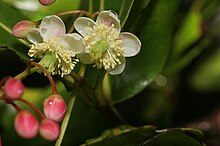| Jellyfish tree | |
|---|---|

| |

| |
| Flower buds, open flowers and the medusa-like dehisced fruit (below) | |
| Conservation status | |
 Critically Endangered (IUCN 3.1) | |
| Scientific classification | |
| Kingdom: | Plantae |
| Clade: | Tracheophytes |
| Clade: | Angiosperms |
| Clade: | Eudicots |
| Clade: | Rosids |
| Order: | Malpighiales |
| Family: | Ochnaceae |
| Subfamily: | Medusagynoideae Reveal |
| Genus: | Medusagyne Baker |
| Species: | M. oppositifolia |
| Binomial name | |
| Medusagyne oppositifolia Baker | |

Medusagyne oppositifolia, the jellyfish tree, is a species of tree endemic to the island of Mahé, of the Seychelles. It is the only member of the genus Medusagyne of the tropical tree and shrub family Ochnaceae. The plant, thought to be extinct until a few individuals were found in the 1970s, gets its common name from the distinctive jellyfish-like shape of its dehisced fruit.
Description
They are small trees which can reach up to 15 m (49 ft) tall and have a dense rounded crown of foliage. The bark is dark and has many distinctive, deep fissures. The leaves are shiny and leathery in appearance with a slightly scalloped edge; they turn bright red with age. Leaves are up to 8 cm (3.1 in) in length. The small white flowers are difficult to see amongst the dense foliage; male and bisexual flowers are carried on the drooping inflorescence. The generic name Medusagyne was given to the plant by John Gilbert Baker who thought that the gynoecium of the flower resembles the head of Medusa from Greek mythology. Baker did not have the dehisced fruit, which resembles a larval hydrozoan or jellyfish, so he did not base the generic name on this resemblance; This dehiscing fruit consists of a single whorl of up to 25 carpels. the vernacular name, jellyfish tree, was applied later possibly based on the appearance of the dehisced fruit and the coincidence that the word medusa is also used to describe the free-floating umbrella-shaped form of jellyfish. This plant exhibits many adaptations to dry climate, strange on a moist archipelago. It can withstand drought, and its seeds disperse by the wind. This suggests it has Gondwanan origins. The fruits are green and rounded; the outer coat becomes reddish-brown with maturity and then dries, exposing the seeds within, which are then distributed by the wind.
Classification
The genus Medusagyne is in the family Ochnaceae, e.g. in the Angiosperm Phylogeny Group classification, though it is sometimes in the monogeneric family Medusagynaceae. The small tropical American family Quiinaceae is also included in this broad concept of Ochnaceae.
Development
The pollen ontogeny of the Medusagyne oppositifolia has some unique features that are shown. These features include a large onci that is composed of fibrilla spacer during the early stage of development to represent the atria section of it.
Habitat
The tree inhabits exposed granite slopes, at present all locations are within 2 km (1.2 mi) of the sea.
Threats
The jellyfish tree presents a conundrum in that the seeds seem unable to germinate in the wild; no young plants have been observed in the natural stands. Successful cultivation in botanic gardens has occurred in very humid conditions, but high humidity is unlikely in the exposed habitat where these trees are found in the wild. It has been suggested that jellyfish trees have been lost from the more appropriate habitat of moist forests through competition with other species and climate change.
Conservation
Three of the existing populations of jellyfish tree on the island on Mahé (Bernica, Copolia and Mt. Jasmin) are protected within the Morne Seychellois National Park. Although seedlings have been grown in a number of botanic gardens, many problems remain and a conservation priority must be further researched into the reproductive biology of this intriguing species before any effective Action Plan for its future can be devised.
References
This article incorporates text from the ARKive fact-file "Jellyfish tree (Medusagyne oppositifolia)" under the Creative Commons Attribution-ShareAlike 3.0 Unported License and the GFDL.
- ^ Matatiken, D.; Huber, M.J. & Ismail, S. (2011). "Medusagyne oppositifolia". The IUCN Red List of Threatened Species. 2011. IUCN: e.T37781A10072208. doi:10.2305/IUCN.UK.2011-2.RLTS.T37781A10072208.en. Retrieved 3 January 2018.
- ^ Wise, R. (1998). A Fragile Eden. New Jersey: Princeton University Press.
- Heywood, Prof. V.H. (1978). Flowering Plants of the World. New York: Mayflower Books. p. 82.
- Hutchinson, John (1959). Families of Flowering Plants -Volume One Dicots. Cambridge, England: Clarendon Press. p. 280.
- Robertson, Ann, Rosemary Wise, and Frank White. 1989. Medusagyne oppositifolia. Curtis's Botanical Magazine, 6: 166–171. doi: 10.1111/j.1467-8748.1989.tb00650.x
- Kingdon, Jonathan (1989). Island Africa: The Evolution of Africa's Rare Plants and Animals. Princeton, New Jersey: Princeton University Press. pp. 42–43. ISBN 0-691-08560-9.
- Fay, M. F., Swensen, S. M. & Chase, M. W. (1997). Taxonomic affinities of Medusagyne oppositifolia. Kew Bulletin 52: 111-120.
- ^ Gerlach, J. (1997). Seychelles Red Data Book. Seychelles: The Nature Protection Trust of the Seychelles.
External links
- Dressler, S.; Schmidt, M. & Zizka, G. (2014). "Medusagyne". African plants – a Photo Guide. Frankfurt/Main: Forschungsinstitut Senckenberg.
| Taxon identifiers | |
|---|---|
| Medusagyne | |
| Medusagyne oppositifolia |
|